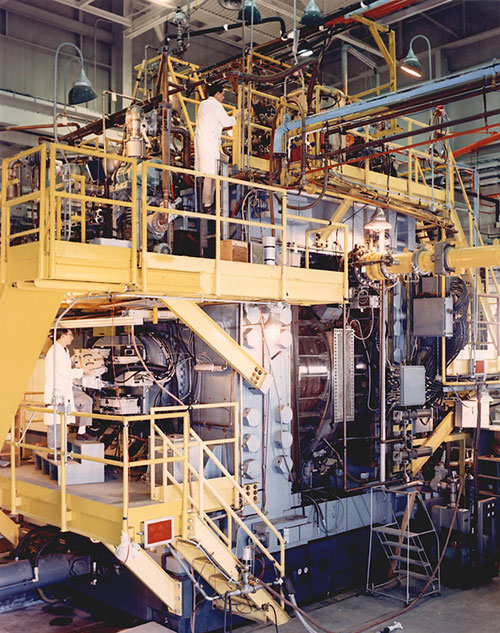The Omega Group
A Brief History
In the early 1970’s the BNL Physics Department reorganized the experimental high energy physics groups. A vote was held for the name of one of the groups and the majority chose “Omega” in recognition of their discovery of the W-, the baryon made of three valence strange quarks, first seen in the BNL 80” bubble chamber in 1964 [1]. The core of this group went on to discover the first charmed baryon, Λc, in n production [2]. A small subset of the group joined the Columbia and Rochester groups to strengthen the evidence for the KoL→µµ decay rate agreement with the Standard Model [3]. Another small subset of the group worked with a collaboration from Cal Tech and LBNL and a segmented electromagnetic calorimeter to measure the inclusive spectra of neutral mesons from various high energy beams at Fermilab. In addition to determining the structure function of mesons versus baryons, a search was made for the charmed partner of the η, the ηc, but it did not have sufficient sensitivity [4].
A large collaboration mostly from BNL and U. of Pennsylvania built a large neutrino detector which was mostly active and measured the elastic scattering of neutrinos and anti-neutrinos on protons [5]. Many other publications came from this apparatus.
A collaboration with the BNL Instrumentation Department and Yale yielded new detectors which measured electromagnetic particles employing a liquid argon calorimeter and transition radiation detector. These detectors were used at the CERN Intersecting Storage Rings, ISR, and found the first observation of the Υ→e+e- and the discovery of direct photons in hadronic interactions [6]. An enlarged collaboration at the ISR on the Axial Field Spectrometer (AFS) led to the first observation of high transverse momentum hadronic jets in pp collisions [7].
After the J/ y discovery in 1974, an experiment was proposed and carried out to search for associated charm meson and baryon production as well as prompt electron pair production, named BNL E686 [8].
Members of the group made a strong commitment to the D0 experiment at Fermilab in the early 1980’s building the finely segmented depleted uranium/liquid argon central calorimeter and the computing infrastructure. This contributed to the discovery of the top quark [9] as well as hundreds of other results.
Part of the group had a leading role in the precision measurement of the g-2 of the µ at BNL [10]. They continued in the even more precise measurement underway at Fermilab.
Some of the group collaborated on a series of measurements and searches of rare K+ decays, see for example [11].
The group contributed to proposals for the U.S. Superconducting Super Collider (SSC) starting with EMPACT and ending with GEM (Gammas, Electrons and Muons). R&D from GEM was brought to the ATLAS experiment at the Large Hadron Collider (LHC) at CERN once the SSC was terminated by the U.S. Congress in 1993. The group contributed to many aspects of the ATLAS detector construction and upgrades as well as managing the U.S. contributions to ATLAS. The contributions to the original construction included parts of the electromagnetic barrel calorimeter including the cryostat and signal feedthroughs, the high rapidity muon spectrometer cathode strip chambers, and software infrastructure. A high point of ATLAS was the discovery of the Higgs Boson in 2012 [12], along with our sister experiment CMS.
References:
[3] W.C. Carithers et al., Further observation of the decay KoL→µ+µ-, Phys. Rev. Lett. 31 (1973) 1025
[9] S. Abachi et al., Observation of the top quark, Phys. Rev. Lett. 74 (1995) 2632

80-inch bubble chamber




